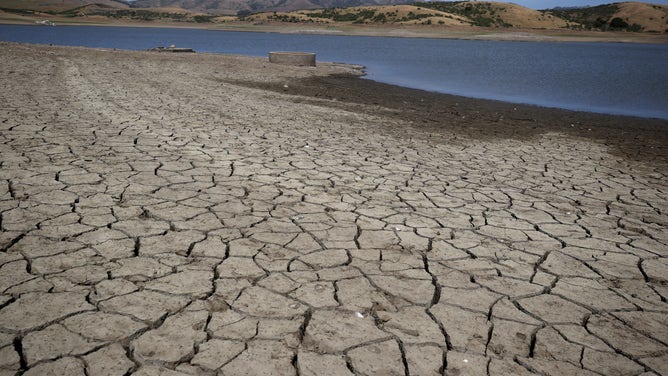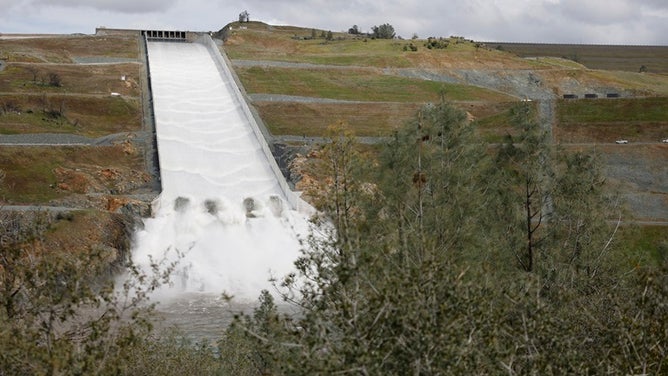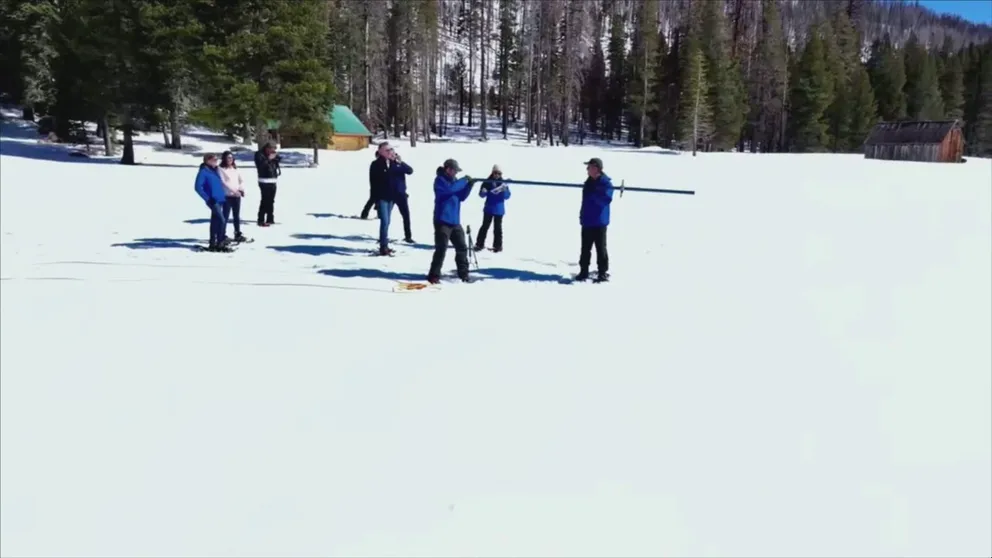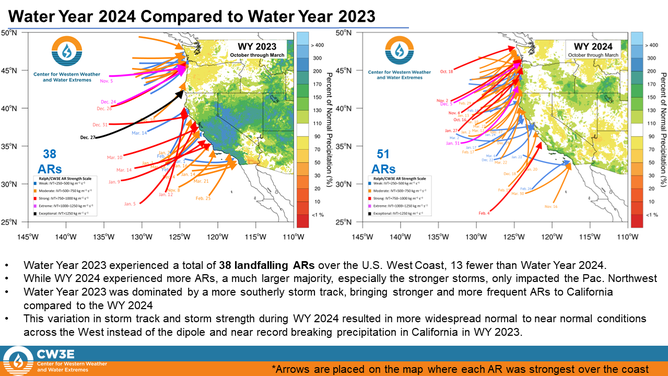California water supply rescued by 'Miracle March' snowpack from several atmospheric rivers
The last snow survey of the season showed an above average amount of water locked up in the snowpack which will feed reservoirs and aquifers when it melts, leaving the state's drinking water supply "in a good place."
'Miracle March' snowstorms put California water supply 'in good shape'
California's water supply is in "a good place right now" according to Andy Reising, California Water Resources Surveyor. Hefty March snowfalls put the state a bit above average for snowpack which melts and fills reservoirs. KTVU FOX 2's Tom Vacar reports. California Department of Water Resources engineer David Rizzardo, Water Resources Director Karla Nemeth and California Natural Resources Secretary Wade Crowfoot also comment.
PHILLIPS STATION, Calif. – Extreme March snowfall amid a train of atmospheric rivers have put California's water supply "in a good place right now," according to the California Department of Water Resources.
"The past month of March was good to us," Andy Reising, water engineer at the DWR, said at a press conference on April 2. "Precipitation and snow fell, and we had a storm that chased us out of here last month. We had several storms since, and that has boosted us from a 75% of average to just above average for for this water year, which is excellent news."
Reising said last year, California was double their average snowpack.
"And it is positive news that the snowpack (this year) caught up over the past few months," Reising said. "We started off with a dry and warm fall. And then the snowpack wasn't very good in the beginning of the winter either. Finally, in the last two months, we've accumulated the snow that has gotten us to this place."
RIDICULOUS PHOTOS SHOW AFTERMATH OF 12 FEET OF SNOW IN CALIFORNIA'S SIERRA NEVADA

The black line shows this year's snowpack which is above average (solid blue.) Last year's snowpack, gray line, was double the average.
(California Department of Water Resources / FOX Weather)
California's water supply is a national concern
The snowpack serves as a frozen reservoir which usually peaks by April 1. Through the spring and summer, the snow slowly melts and refills reservoirs to supply 30% of the state's water needs.
"Many of us growing up learned the old adage, April showers bring May flowers. Well, in California we know that winter snows bring summer flows," said Wade Crowfoot, state Secretary of Natural Resources. "And that snowpack will turn into water to provide drinking water for upwards of 40 million Californians, the lifeblood of our agriculture sector and our economy – the fifth largest in the world. Water that literally defines the home for fish and wildlife, and remarkable ecosystems across California that are the richest and most diverse, ecosystems to be found in the world."
California grows more than a third of all vegetables and three-quarters of the fruits and nuts consumed in the U.S., according to the California Department of Food and Agriculture. So, the California water supply is a national concern.
HOW DO RAIN AND SNOWMELT FEED WELLS?

File: Trailers full of tomatoes before processing. California grows over 95% of the country's tomatoes and 30% of the world's.
(Andia/Universal Images Group / Getty Images)
West Coast drenched by 51 atmospheric rivers over past winter
About half of California's water supply comes from atmospheric rivers (ARs), according to the DWR.
The Center for Western Weather and Water Extremes reported that 51 atmospheric rivers made landfall over the West Coast for the Water Year 2024. October through December though, did start slowly with only 18 ARs making landfall in Northern California with six rated as moderate strength. Then the state saw 25 from January to March – nine of which ranked moderate and two strong) and the snow and water supply caught up.
Water officials say, on average, the state sees five or six atmospheric rivers per water year (WY), which spans from Oct. 1 to Sept. 30.
RELENTLESS CALIFORNIA ATMOSPHERIC RIVERS DROP 32 TRILLION GALLONS OF WATER OVER 3 WEEKS
The 2023 water year saw 38 landfalling ARs – fewer than in 2024, but those in 2023 were stronger. That year, California had seven strong, extreme or exceptional ARs which nearly equaled the amount of water seen in the three prior years of drought. In 2024, the state only saw two.
"The water year 2023 was dominated by a more southern storm track, bringing stronger and more request ARs to California compared to the WY 2024," wrote the Center for Western Weather and Water Extremes (CW3E). "The variation in storm track and storm strength during WY 2024 resulted in more widespread to near normal conditions across the West instead of the dipole (north versus south) and near record-breaking precipitation in California in WY 2023."
The strongest AR in 2024 hit Central and Southern California in early February. Los Angeles saw 8.51 inches of rain over three days, the second-wettest three-day stretch in the city's history. At the same time, the Sierra Nevada snowpack increased by 10-20%.
CALIFORNIA VINEYARD EXPECTS ‘BUMPER’ CROP THIS YEAR THANKS TO ATMOSPHERIC RIVERS
Despite average snowpack, California still has work to do to avoid water shortages
The race is on now to capture as much of that melt as possible without stressing reservoir capacities and flooding lowlands. But the DWR urges the state to collect even more water to have on hand for drought years.
"Average is awesome. We've had some pretty big swings in the last couple of years, but average may be becoming a less and less common feature of snowpack in California," said DWR Director Karla Nemeth. "The snowpack in California has traditionally been about two thirds of our overall storage. So what it means into the future is we need to continue to invest in how we store this water when we know dry conditions return."
The governor echoed her concerns.
CALIFORNIA DROUGHT COST THE STATE'S AG INDUSTRY BILLIONS IN 2022, SAYS STUDY

File: This cracked, dry reservoir bed in Northern California looks like most around the state in the third year of drought.
(Justin Sullivan/Getty Images / Getty Images)
"The hot is getting a lot hotter, the dry is getting a lot drier and the wet is getting a lot wetter," said Gavin Newsom at the press conference. "And that requires us to have a sophistication of approach that includes new strategies for stormwater capture, high flow stormwater capture, groundwater replenishment, water recycling; the strategies to make conservation a way of life, strategies that incorporate proven solutions at the federal level."
He brought up research that said, due to climate change, the world would have 10% less clean water by 2040. In response, the state is planning the first new reservoir in over 50 years.

File: In March 2023, the Oroville Dam spillway was opened for first time since 2019 to stop the reservoir from overfilling.
(California Department of Water Resources / FOX Weather)
"California has had two years of relatively positive water conditions, but that is no reason to let our guard down now," Michael Anderson, California State Climatologist, said in a statement. "With three record-setting multi-year droughts in the last 15 years and warmer temperatures, a well above average snowpack is needed to reach average runoff. The wild swings from dry to wet that make up today’s water years make it important to maintain conservation while managing the runoff we do receive. Our water years moving forward will see more extreme dry times interrupted by very wet periods like we saw this winter."
We can't take snowpack for granted anymore, Crowfoot concluded.



